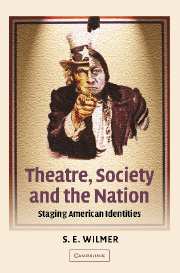Book contents
- Frontmatter
- Contents
- Acknowledgements
- Introduction
- 1 From British colony to independent nation: refashioning identity
- 2 Federalist and Democratic Republican theatre: partisan drama in nationalist trappings
- 3 Independence for whom? American Indians and the Ghost Dance
- 4 The role of workers in the nation: the Paterson Strike Pageant
- 5 Staging social rebellion in the 1960s
- 6 Reconfiguring patriarchy: suffragette and feminist plays
- 7 Imaging and deconstructing the multicultural nation in the 1990s
- Notes
- Select bibliography
- Index
4 - The role of workers in the nation: the Paterson Strike Pageant
Published online by Cambridge University Press: 22 September 2009
- Frontmatter
- Contents
- Acknowledgements
- Introduction
- 1 From British colony to independent nation: refashioning identity
- 2 Federalist and Democratic Republican theatre: partisan drama in nationalist trappings
- 3 Independence for whom? American Indians and the Ghost Dance
- 4 The role of workers in the nation: the Paterson Strike Pageant
- 5 Staging social rebellion in the 1960s
- 6 Reconfiguring patriarchy: suffragette and feminist plays
- 7 Imaging and deconstructing the multicultural nation in the 1990s
- Notes
- Select bibliography
- Index
Summary
During the second half of the nineteenth century, the industrial revolution spread across the United States, introducing mechanized farming and mining, huge industries and the transcontinental railroad. Immigration increased dramatically, not only from northern Europe but also from southern Europe and Asia (until checked by the Chinese Exclusion Act of 1882). Thirty-five million people immigrated into the United States from 1815 to 1920, and at the end of the nineteenth century gravitated to the cities in such numbers that overcrowding and unhealthy living conditions resulted. Jobs in industry frequently involved repetitive tasks and, particularly with the coming of the assembly line and the waning of craft industries, little sense of personal achievement. Laborers complained of low wages, long hours and poor conditions, but the ready supply of immigrant labor could be exploited to replace those who were dissatisfied. The giants of industry and banking such as Rockefeller, Morgan, Harriman, Gould, Vanderbilt, Carnegie and Ford acquired unprecedented wealth while workers often suffered in poverty. Labor unions, such as the American Federation of Labor (AFL) which concentrated on skilled workers within specific crafts, formed to demand shorter working days, decent conditions and an adequate wage. Strikes became frequent and industrialists resorted to scab labor and police intimidation to break them. Disputes often led to bloody battles such as the Carnegie steel plant strike in Homestead, Pennsylvania (1892) and the Pullman strike in Chicago (1894).
- Type
- Chapter
- Information
- Theatre, Society and the NationStaging American Identities, pp. 98 - 126Publisher: Cambridge University PressPrint publication year: 2002



